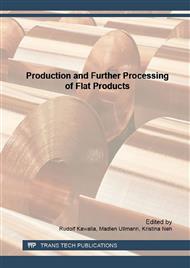p.3
p.9
p.16
p.22
p.29
p.35
p.42
p.51
p.57
Production of Directly Quenched High-Strength Hot-Rolled Strip Steels - Influence of Rolling and Cooling Conditions on Mechanical Properties and Flatness
Abstract:
The production of hot-rolled sheets of high-strength and wear-resistant special structural steels by direct quenching from the rolling heat is a cost effective and energy-saving alternative to traditional production via downstream quenching the previously cut-to-length plates. Reaching the required strength and toughness parameters in combination with best flatness of the sheets requires strict compliance with the pre-set rolling and cooling conditions over the entire strip width. Using two high-strength low-alloyed steels, plant trials have been carried out to study the effect of the cooling conditions and the coiling temperature on mechanical properties, impact toughness and flatness of cut-to-length sheets made of hot-rolled strip. The results showed that by applying optimized cooling pattern and low coiling temperatures, high-strength steel sheets with outstanding mechanical properties and good flatness can be produced.
Info:
Periodical:
Pages:
29-34
Citation:
Online since:
May 2016
Authors:
Permissions:
Share:
Citation:


